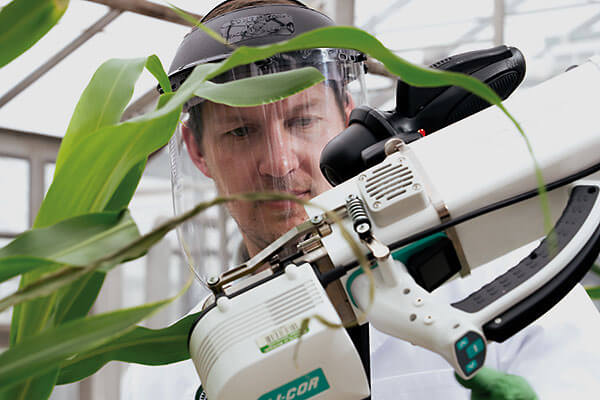
Most high school biology students learn that plants use photosynthesis to turn light into energy.
That understanding just scratches the surface, said GLBRC investigator Berkley Walker, an associate professor of plant biology at Michigan State University whose research was spotlighted in a recent story by the university's College of Natural Science.
Plants use that energy to capture carbon dioxide, or CO2, from the atmosphere and convert it into sugars. These sugars are the building blocks plants use to grow. From the time a seed sprouts out of the ground, a plant uses CO2 to make every compound it needs for life.
"That fundamental process of grabbing CO2 out of the atmosphere sits at the crux of how our Earth is impacted by changing CO2 and temperatures," Walker said.
In some respects, giving plants more CO2 is like giving a person more hamburgers. If they eat more, they'll get bigger. The caveat is temperatures are also increasing. When that happens, photosynthesis gets sloppy.
Occasionally, instead of grabbing carbon dioxide, a plant grabs oxygen instead. The plant is then stuck dealing with accidental oxygen molecules, a process called photorespiration.
Under normal circumstances, photorespiration happens about once out of every five reactions in which a plant is supposed to grab CO2. As temperatures heat up, plants accidentally grab oxygen even more often. The result is wasted energy, and photosynthesis is less efficient.
"That's one big thing my lab looks at," Walker said. "It's this interplay between, what is increasing CO2 going to do? What are increasing temperatures going to do? And how does that affect the total amount of carbon in plants, and what do they do with that carbon once they've turned it into sugars?"
To study the interplay between increasing CO2 and rising temperatures, Walker uses the plant science equivalent of a lab rat — Arabidopsis thaliana, or mouse-eared cress. The plant's six-week life cycle makes it the perfect specimen for quick study results.
Walker's lab grows it in chambers that replicate high CO2, high temperature conditions. They use a laser to measure the leaf's CO2 composition before and after, giving them a snapshot of how the plant moves carbon from outside to inside the leaf.
Inside the MSU Research Greenhouse Complex, Walker's lab creates programmable droughts. Each pot has its own soil moisture sensor and drip irrigation system. This gives researchers an accurate read on what happens to plants with limited water, another stressful condition that's becoming more common.
Understanding how plants respond to stress will be key to preserving agricultural systems as climate change shifts growing zones north. Some models already show the wheat belt moving out of the United States and into Canada, Walker said.
"Looking toward future conditions, I think the plants will be just fine," Walker said. "But as far as having the plants do what we want them to do, where we want them to do that — that may not be the case."
Read the entire story on MSU's College of Natural Resources website.